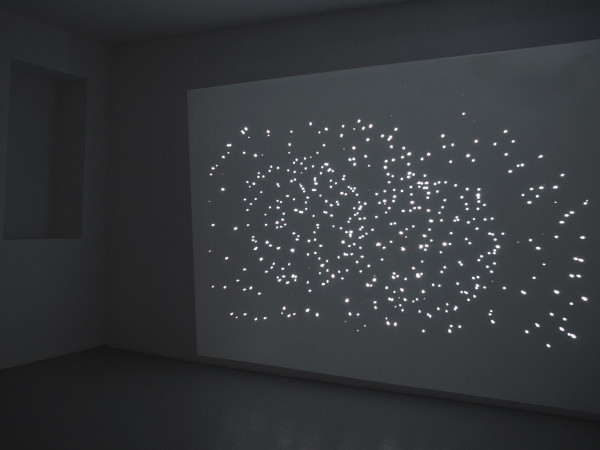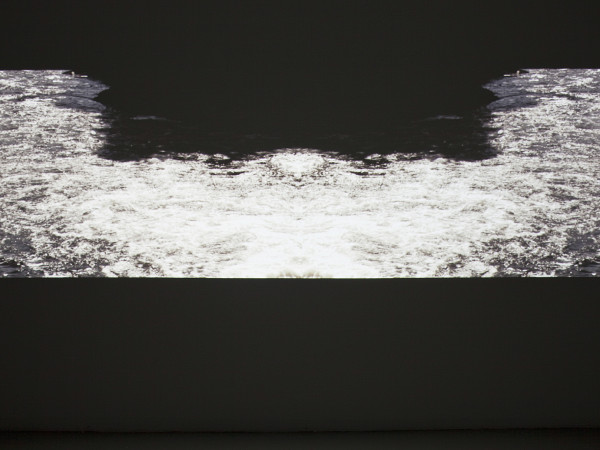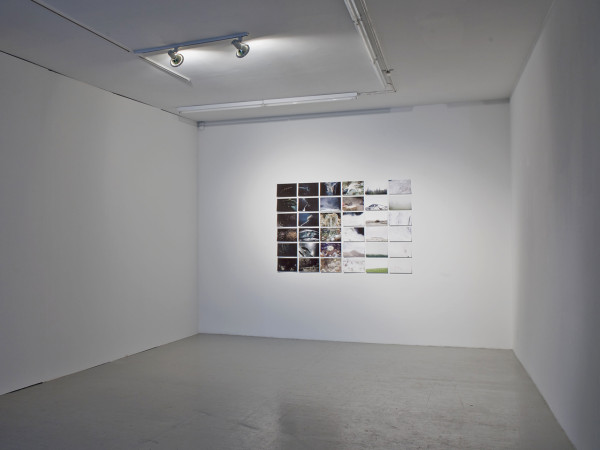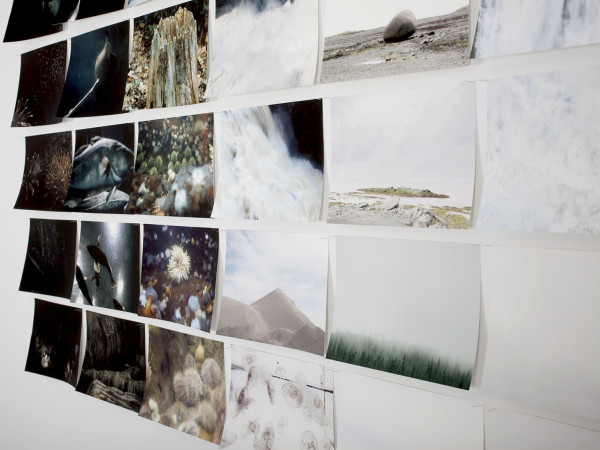We share the same sky. Scattered above our heads are stars, stories, bits of life beginning. Around us, multiple landscapes, but always the same elements: earth, water, fire and air that captivate our imagination, fascinating formless, changing matter. To this fascination is added a certain state of contemplation, which most certainly inspires the work of Silvia Camporesi an artist of Italian origin and which makes up, in conjunction with a partiality for dreaming, her distinctive mark.
Describing herself as a storyteller, Silvia Camporesi creates images that find their origin in excerpts of stories drawn from myths, literature, philosophy, religion and science. Exploring her surroundings through a photographic approach, the artist makes unexpected realities appear. Presented in unaccustomed form, what earlier seemed to be factual becomes an invitation to reflect and consider what makes up the theatre of our everyday life with new meanings and justifications. During her creative residency at LA CHAMBRE BLANCHE, it was Quebec City’s turn to be transformed through Silvia Camporesi’s vision, which skilfully infused a portion of fiction into natural and artificial phenomena encountered during her stay. Within a collection of compiled still and moving images, the artist tells of imagined landscapes bathed in fluid light.
As you enter into the gallery, the immaculate white of the exhibition space draws you towards the back wall where a pictorial composition made up of thirty-six photographs gradually changes from black to white, from appearance to disappearance. Primarily an effect of weightlessness: In the darkness of still water, the fish inhabit the sky. In fact, the remarkable organization of photographic images “places the bird in deep water and the fish suspended in the air,”1 recalling the optical illusion of a starry sky reflecting on the surface of an aqueous expanse. This organisation of photographs confuses our understanding of their contents. The depths of the aquatic world and the vast celestial expanse become the same space; at times dark and heavy like thick velvet and at other times, as diaphanous as a veil. In this installation, we become strangers in our own landscape, where the immensely large and the infinitely small keep company. Reduced to a similar format, they give the impression of a romantic study of life with formal associations as unusual as the appearance of a sea animal in a fireworks display. Then finally, snapshots of earth, dunes, a forest, a meadow, and among these photographs, the woolly mantle of powerful waves appear one after another. At first glance, you might think of a mosaic free from traces of humanity. This is not the case however. Based on natural elements, a tarpaulin covering mounds of what we guess to be spreading salt has the effect of an imposter and suggests that we are in well-known territory. Scanning this meticulous assemblage of photographs from left to right, we make out through an impenetrable fog, an emblematic Quebec City factory and finally the Canadian flag. Although the grouping right away stimulates an aesthetic response, one discovers that it reveals a silent and eminently dreamlike narrative framework. Silvia Camporesi juxtaposes urban elements and natural matter with disconcerting ease, at the same time amusing herself as she gives us the impression of an uninhabited world, a New World, all while tracing signs of human presence there. The artist succeeds in presenting visual and discursive contrasts that leads us to dissolve into a heterogeneous, fragmented temporality, as if she is preparing us for her next work.
Full of white light, the gallery presenting the photographic installation is adjacent to a closed space, where one is immersed in darkness. Like “a new artificial star participating in both day and night,”2 Silvia Camporesi’s video work opens this pixelated material with a luminous choreography of particles created by the slowed-down explosion of fireworks. In front of this spectacle that the artist has decomposed and recomposed, we have the impression of being present at the formation of the universe, an imagined, mystical Big Bang. These intermittent irruptions of light that emerge from chaos could, by disappearing in the smoky darkness, leave us with the idea of dispersion: it is different however. Their slow and concentric movement instead tends to simulate something like the process of becoming, like the organisation of life. Sounds accompanying this seem to come from far away; pulsations and voices, on a background of solemn vibrations, make the viewer a stroller in the cosmos, even positioning him or her in utero in this world in gestation. Time is suspended until these artificial stars are completely absorbed in the night. A muted sound follows this vision, like the first breath of the earth, and the whiteness of drizzle dances around behind a boulder. This second part of the video seems to be a sequel to the first in an antinomical relationship. Water is the main subject of the sequence. Waves break with force on rocky slopes. Through the artist’s work on distortion, the strength of this element is brought to light. The reversions of movements carried out with videos give the impression of breathing, as if the earth inhales the current, filling its lungs. The sound of reverberation juxtaposed with the noise of the falls gives free rein to this reverie fuelled by impossible landscapes, increasing tenfold. In this play of deconstruction, subtle pictorial research appears in which the compositions and textures give way to seduction. Large stretches of troubled water cross the smooth surface of a rock face following those that are eddying, to form a dense bubbling through the dynamic effect of flowing water. At other moments, the water separates into two and is reflected on a vertical axis, as if to show us its face in perfect symmetry. This strategy of assembled images is found in a previous corpus of the artist titled Le Ragioni del Peso (2009), in which a landfill site makes the photographic subject sway between aesthetic transfiguration and documentary veracity. The images produced recall those of a Rorschach test and take on a related role: that of a projection space in which the viewer elucidates an abstraction. Through simple image manipulations, Silvia Camporesi challenges the apparent immutability of the elements and makes reality take a sudden turn towards the imagination.
We share the same sky certainly, but its poetry is not the same for everyone. In the creative work produced during her stay at LA CHAMBRE BLANCHE, Silvia Camporesi appropriated fragments of landscape and elements encountered during almost tourist-like outings to create a sublime allegory that transcends the vernacular from a distance. When in contact with the works that make up the project À perte de vue, time becomes reversible, out of sync. We are invited to look beyond the apparent banality of things: her work has the effect of making a discovery, of revealing a secret. Working from known elements, the artist accentuates her works with the distortions and discontinuities that form reality and presents an open narrative. This mysterious rewriting of the world, carried out during her residency in Quebec City, falls within the corpus in which water is an integral part of the work. In fact, since 2004, Silvia Camporesi has been working with this element: for the series Ofelia, she personified the famous heroine who, languishing for Hamlet’s love, found death in a river. This striking image will be cited many times in the artist’s various works, notably in her very recent series La Terza Venezia (2011) produced at a residency in Venice. Presenting enigmatic and surreal images of flooded monuments, of hazy landscapes and typically Venetian objects installed in anonymous places throughout the famous city on the water, Silvia Camporesi is thoughtfully cultivating ambiguity. Sometimes heavy and stifling, other times light and airy, even clear, water appears as an all powerful element in the ensemble of her work. “The true eye of the earth is water. It is the gaze of the earth,”3 as Paul Claudel affirms, and Silvia Camporesi probes it to her very depths, looking it straight in the eye.
- Bachelard, Gaston. 2011, Water and Dreams an Essay on the Imagination of Matter. Dallas: Dallas Institute of Humanities & Culture editions. p. 64 an excerpt from Edgar Allan Poe’s Landor’s Cottage.
- Mèredieu, Florence de. 2008, Histoire matérielle et immatérielle de l’art contemporain et actuel. Paris: Larousse editions. p. 85.
- Claudel, Paul. 1929, The Black Bird in the Rising Sun. Paris, Gallimard editions. p. 229.



